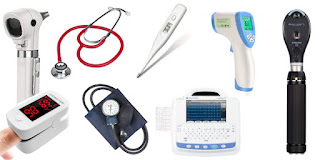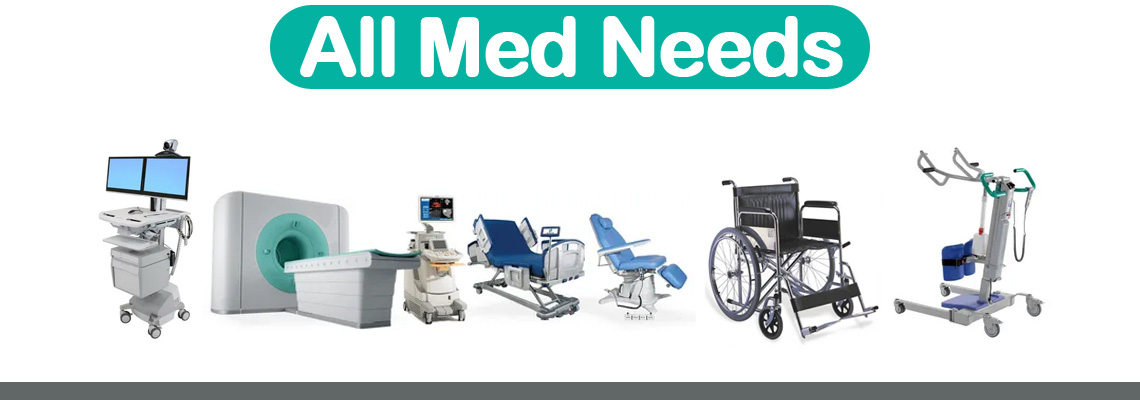Diagnostic medical equipments are a form of device or tool used in a hospital setting for the sole goal of diagnosing a patient's condition is referred to as diagnostic medical equipment. A diagnostic test is performed using the necessary technology to evaluate the patient internally based on the symptoms stated by the patient. The doctor or technician is looking for any abnormalities that are causing the symptoms to appear in the affected organs or sections of the body.

Clinicians use diagnostic medical equipments and supplies to measure and examine many elements of a patient's health in order to make a diagnosis. The clinician can then recommend a suitable treatment plan once a diagnosis has been made.
Diagnostic medical equipments can be found in adult and paediatric outpatient care centres, emergency rooms, inpatient hospital rooms, and intensive care units.
The following list is by no means comprehensive, but it does provide an overview of some of the most widely used diagnostic tools.
1. Stethoscopes
Stethoscopes are the most well-known of all medical diagnostic medical equipments. They're used to listen to heart and lung noises, as well as blood flow in the arteries and veins.
Stethoscopes aid in the diagnosis of:
- Pneumonia
- Bronchitis
- Heart disease
- Heart palpitations
- Heart valve issues
- Arrhythmia
Blood pressure is also measured using stethoscopes and a sphygmomanometer.
When listening to low-pitched heart sounds and high-pitched lung sounds, electronic stethoscopes improve sound quality. They can be connected to a computer so that the sounds can be recorded and saved. They can be connected to distributors, allowing numerous individuals to listen to the same stethoscope at the same time. When it comes to training interns, residents, and fellows, this last element is crucial.
2. Thermometer
From basic physical exams to emergency room triage through inpatient care, thermometer medical equipments are used in all sectors and levels of care. Electronic thermometers have been developed to reduce the time it takes to take a patient's temperature. The electronic ones can be programmed to measure a particular part of the body, such as the mouth, beneath the armpit, rectally, or the ear.
3. Pulse Oximetry
Pulse oximetry technology has enabled enormous advancements in the medical realm, but its usage in dentistry has remained mostly unexplored. The pulse oximeter's ability to determine vascular integrity within the human tooth is investigated in this study. The pulse oximeter revealed that the vital teeth had a pulse rate and oxygen saturation value, but no readings for the teeth that had previously been endodontically treated. The precision of this diagnostic medical equipment underpins the necessity for more research into the use of a pulse oximeter to evaluate pulp pathological processes.
4. Sphygmomanometer
Blood pressure monitoring is vital in establishing a person's general health, according to evidence-based medicine.
The sphygmomanometer medical equipments can aid in the diagnosis of:
- Diabetes
- Blood pressure can be either high or low.
- Hardening of the arteries
- Plaque on the arterial wall
- Hypotension
Several disorders have been associated to high blood pressure. Blood pressure is measured with a few different devices. Manual sphygmomanometers are thought to be the most accurate.
Mercury manometers don't need to be calibrated on a regular basis, thus they're only utilised in high-risk situations.
Aneroid sphygmomanometers are less dependable since they can lose their calibration when bumped, which happens all the time in healthcare. Wall-mounted designs can help to decrease this risk, but calibration checks should still be done to be sure. The mechanical aneroid style is easily recognised as a device having a dial for readings, as well as a bulb and air valve.
The smallest and most portable blood pressure monitors are digital finger blood pressure monitors. They're simple to use, but they're not very accurate.
Digital sphygmomanometers medical equipments are electronic, just like digital finger blood pressure monitors. They can be manually or mechanically inflated. They are simple to use, however they only calculate blood pressure indirectly. The average of the systolic and diastolic pressures is measured by digital units, which are used to calculate mean arterial pressure. The systolic and diastolic measurements must then be calculated using the digital sphygmomanometer. These are useful in loud environments where manual mercury manometers would be unsuccessful due to the clinician's requirement to hear the Korotkoff sounds.
5. Ophthalmoscopes
Ophthalmoscopes are handheld medical equipments that allow a doctor to see inside a patient's fundus. In physical or outpatient tests, this type of diagnostic instrument is frequently utilised.
Ophthalmoscopes medical equipments can aid in the diagnosis of:
- Bacterial infections
- Detached retinas
- Glaucoma
Ophthalmoscopes are divided into two categories.
Direct ophthalmoscopes produce an upright image with a magnification of about 15 times. These medical equipments are held as close as feasible to the patient's eye.
Indirect ophthalmoscopes create an inverted image with a magnification of 2 to 5 times. Ophthalmoscopes are held 24 to 30 inches away from the patient's eye with indirect ophthalmoscopes. Indirects also offer a stronger light source, making them more beneficial in cataract patients than directs.
6. Otoscopes
Otoscopes are handheld medical equipments that allow doctors to peer into the ear canal and magnify the tympanic membrane.
Otoscopes aid in the diagnosis of:
- Ear infections
- Tinnitus
- Causes of vertigo or dizziness
- Meniere’s disease
- Swimmers ear
The otoscope's head also features a light. The light, in combination with the magnifying lens, allows you to examine the outer and middle ear. The disposable speculum is the part that the doctor inserts into the ear canal. Disposable specula are kept in a dispenser in the exam room so that each patient's otoscopes can be replaced with a fresh, clean one.
7. Electrocardiographs
Electrocardiographs monitor the heart's electrical activity. The heart rate, as well as the regularity of the beats, can be measured during this test. These are two important signs of any heart problems. An electrocardiograph can also be used to determine the size and position of each heart chamber. Finally, the electrocardiograph medical equipments are used to diagnose cardiac disease as well as the impact and efficacy of medicine treatment or device implantation.

